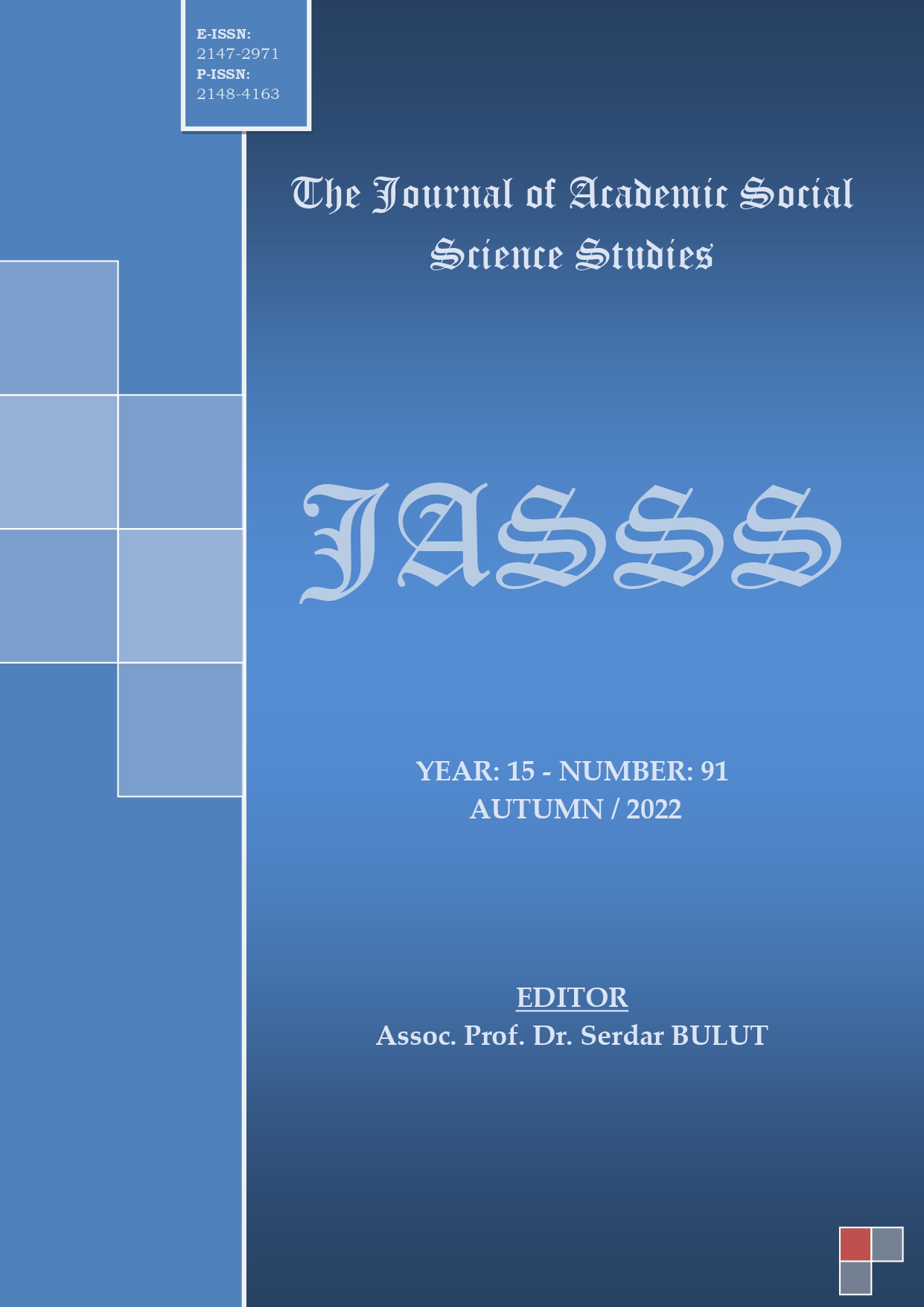Author :
Abstract
Deyim; genellikle gerçek anlamından az çok ayrı, kendine özgü bir anlam taşıyan kalıplaşmış söz öbeği, tabir olarak tanımlanabilir. Anlam biliminde aralarında anlamsal bir yakınlık, ilişki ve bütünlük bulunan göstergelerin oluşturduğu alana ise kavram alanı denir. Bu çalışmanın amacı Türk dilinin en çok konuşana sahip iki lehçesi olan Özbek Türkçesi ve Türkiye Türkçesi söz varlığındaki “at” kavram alanına giren dilsel göstergelerin yer aldığı deyimleri tespit etmek ve bu deyimlerdeki ilgili sözcüklerin deyimlere kattıkları anlamların tespiti yapmaktır. Bu iki lehçe özellikle yazılı edebiyat olarak kesintiye uğramadan yüzyıllardır devam eden bir canlılığa sahiptir. Çalışmada her iki kültürde önemli bir yer tutan atın deyimlerde hangi anlamlarda kullanıldığını tespit edilmiş, anlam olarak aynı ve yakın anlamlı olanlar listelenmiştir. “At” kavram alanına giren kelimeler tespit edilereksözlük oluşturulmuştur. Oluşturulan bu sözlük ile Türkçenin iki lehçesindeki at kavram alanındaki deyimlerde geçen kelime varlığı ortaya konulmaya çalışılmıştır. Bu çalışma, nitel araştırma yaklaşımında döküman analizi yöntemiyle gerçekleştirilmiştir. Türk Dil Kurumu tarafından yayımlanan “Atasözleri ve Deyimler Sözlüğü” ile Ömer Asım Aksoy’un “Atasözleri ve Deyimler Sözlüğü”, Özbek Tilinin İzahli Lugati ve Şevket Rahmatullayev’in Frazeologik Lugat’i deyimleri tespit etmek için taranan kaynaklardır. Çalışma sonucunda Türkiye Türkçesinde “at” kavram alanına giren 66, Özbek Türkçesinde ise 17 deyim tespit edilmiştir. Elbette sözlü dilde, bundan fazla olduğu düşünülmektedir. Türkiye Türkçesindeki deyimler sadece anlamları ile Özbek Türkçesindeki deyimler ise hem Özbek Türkçesindeki anlamları hem de Türkiye Türkçesindeki tercüme anlamları ile birlikte verilmiştir. Oluşturulan dizin kısmında ise 24 kelime tespit edilmiştir. Bu kelimelerin iki lehçedeki karşılığı ve Türkiye Türkçesindeki anlamları yazılmıştır.
Keywords
Abstract
Idiom can be defined as a stereotyped phrase, phrase that usually has a specific meaning, more or less separate from its true meaning. In the semantics, the area formed by the signs that have a semantic closeness, relationship and integrity between them is called the conceptual field. The aim of this study is to determine the idioms that include linguistic indicators that fall under the concept of "horse" in the vocabulary of Uzbek Turkish and Turkey Turkish, which are the two most spoken dialects of the Turkish language, and to determine the meanings of the related words in these idioms. These two dialects have a vitality that has continued for centuries without interruption, especially as written literature. In the study, it has been determined in which meanings the horse, which has an important place in both cultures, is used in idioms, and the ones with the same and close meanings are listed. The words that fall into the concept of "horse" were determined and a dictionary was created. With this dictionary created, the existence of words in idioms in the conceptual field of horse in two dialects of Turkish has been tried to be revealed. This study was carried out with the document analysis method in the qualitative research approach. “Atasözleri ve Deyimler Sözlüğü” published by the Turkish Language Association, and “Atasözleri ve Deyimler Sözlüğü” by Ömer Asım Aksoy, Özbek Tilinin İzahli Lugati and Frazeologik Lugat of Şevket Rahmatullayev are the sources scanned to identify idioms. As a result of the study, 66 idioms that fall under the concept of "horse" in Turkey Turkish and 17 idioms in Uzbek Turkish were determined. Of course in the spoken language, it is thought to be more than that. Idioms in Turkey Turkish are given only with their meanings and idioms in Uzbek Turkish with their meanings in both Uzbek Turkish and translation meanings in Turkey Turkish. In the created index part, 24 words were determined. The equivalents of these words in two dialects and their meanings in Turkey Turkish are written.
Keywords
- Aksan, D. (2000). Her Yönüyle Dil: Ana Çizgileriyle Dilbilim. Ankara: Türk Dil Kurumu Yayınları.
- Aksan, D. (2000). Her Yönüyle Dil: Ana Çizgileriyle Dilbilim. Ankara: Türk Dil Kurumu Yayınları. Aksan, D. (2015). Türkçenin Sözvarlığı. Ankara: Bilgi Yayınevi.
- Aksoy, Ö. A. (1971). Atasözleri ve Deyimler Sözlüğü. Ankara: Türk Dil Kurumu Yayınları. Aksoy, Ö. A. (1988). Atasözleri ve Deyimler. Ankara: Türk Dil Kurumu Yayınları.
- Akyalçın, N. (2012). Türkçemizin Anlamsal Zenginlikleri Deyimlerimiz. Ankara: Eğilen Kitap Yayınları.
- Begmatov, E.; Madvaliyev, A.; Mahkamov, N.; Mirzayev, T.; To‘hliyev, N.; Umarov, E.;Xudoyberganova, D. ve Hojiyev, A. (2006-2008). O'zbek Tilinin İzohli Lug'ati. Özbekistan: O’zbekiston Milliy Ensiklopediyası Davlat İlmiy Nashriyoti.
- Bozkurt, F. (1995). Türkiye Türkçesi. İstanbul: Cem Yayınları.
- Çınar, A. A. (1995). Divan-ı Lügati't Türk'te At Kültürü. İstanbul: Türk Kültüründe At ve Çağdaş Atçılık Türkiye Jokey Kulübü.
- Gürsoy-Naskali, E. (1995). Türk Kültüründe At ve Çağdaş Atçılık. İstanbul: Türkiye Jokey Kulübü.Kafesoğlu, İ. (1995). Türk Millî Kültürü. İstanbul: Boğaziçi Yayınları.
- Korkmaz, Z. (1992). Gramer Terimleri Sözlüğü. Ankara: Türk Dil Kurumu Yayınları.
- Özcan, A. Ö. (2000). Hayvanlarla İlgili Özbek Atasözleri. Türk Dünyası Dil ve Edebiyat Dergisi, 0(9), 114- 159.
- Rahmatullayev, S. (1978). O'zbek Tilinin İzohli Frazeologik Lugati. Taşkent: O'qituvchi Nashriyati.
- Sertkaya, O. F. (1995). Eski Türk Kültüründe At. İstanbul: Türk Kültüründe At ve Çağdaş Atçılık Türkiye Jokey Kulübü.
- Turan, F. (2017). Hindistan’da Yazılmış Çağatayca Sözlüklerde At ve Atçılığa Dair Kelimeler. Ankara: Günce Yayınları.
- Tutel, E. (1998). At ve Atçılık. İstanbul: İletişim Yayınları.
- Türk Dil Kurumu İnternet Sitesi. (2022, 28 Mart). Türk Dil Kurumu Güncel Türkçe Sözlük. https://sozluk.gov.tr/ adresinden 28.03.2022 tarihinde erişildi.
- Yusupova, N. (2018). Türkçe - Özbekçe Sözlük. Ankara: Türk Dil Kurumu Yayınları.





